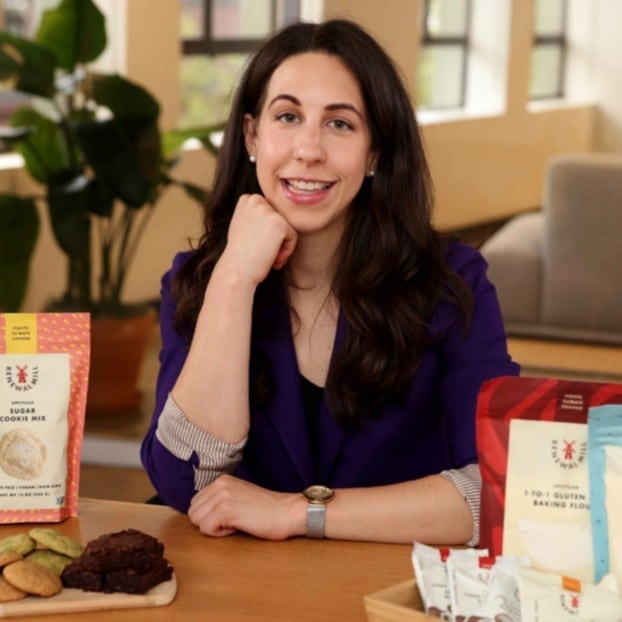
Caroline Cotto serves as board president of one organization and COO of another. She shares her tips on how to build inclusive, diverse boards.
“Nobody else is going to blaze the trail. If you think you’re qualified and passionate about an organization, just get involved.” — Caroline Cotto
Building a board from scratch, much like reusing plant-based pulps to create nutritious cookie mixes, takes creativity and patience. Caroline Cotto is doing both.
Caroline, who was named in the 2022 Forbes 30 under 30 list, is the inaugural board president for the Upcycled Food Association (UFA) as well as Co-Founder & COO of Renewal Mill. Both of these organizations are dedicated to promoting equitable and sustainable food systems. Internally, they are also both dedicated to promoting equal leadership for women and men, and building environments where every voice is heard. This, in particular, has been a key part of Caroline’s challenge and goal as UFA’s Board President.
Caroline leans on lessons from her eclectic career—from working on Michelle Obama’s Let’s Move! Initiative to running HubSpot’s women’s diversity program. She’s passing along her wisdom on:
- How she is turning a board of competitors into united collaborators
- Secret ingredients for better communication and achieving board goals
- Why boards must be intentional about diversity and inclusivity from day one
Lessons Learned in Building a Board from the Ground Up
The origins of UFA don’t make for your typical board, per se. They actually started as a Facebook group for those interested in supporting food upcycling—which is the process of reusing food that would otherwise go to waste, such as misshapen fruits and vegetables or juice pulp, and turning it into cookie mixes, energy bars, and other snacks. For instance, Renewal Mill upcycles pulps to create nutrient-rich ingredients for cooking and baking. She helped start the Facebook group because she too is passionate about making food upcycling the norm.
“We wanted to help streamline the narrative around food upcycling,” she says. “So we all got connected and joined forces.”
While the Facebook group was growing, they knew they needed someone to manage the process of creating a formal definition of and certification for upcycled food; so they decided to become a formal trade association. Today, the Upcycled Food Association has over 200 members—including most of the leading upcycled food startups alongside industry titans like Dole, Kroger, Del Monte, Mondelez, and more.
When asked to join the board at UFA, Caroline knew it was the right next step—and she knew she wanted to run for board president.
“I thought, ‘I’m already spending so much time on this, and I have strong opinions on how this should be developed—so that Renewal Mill can be developed but also so that all my friends [in the industry] can benefit,” she says. “I have a vision as to what the future can look like, and I want to see it executed.”
Now as UFA’s inaugural board president, Caroline has learned a few key ingredients for success.
Turn Competitors into Allies
Unlike other boards, the UFA is made up of individuals from like-minded food upcycling companies, who also compete with each other. However, they are after the same thing—to promote upcycling food. With that in mind, the UFA board was united by a shared goal: to create a formal certification for upcycled foods and spread awareness of the growing industry.
“It’s interesting to start a nonprofit board where everybody is from competing for-profit companies,” Caroline says. “We really went into it with the idea that a rising tide lifts all boats, and we have to all be in this together.”
Being competitors creates a unique dynamic that Caroline wanted to address when stepping in as board president. In the beginning, the board met monthly (now they meet quarterly) and she focused on building team bonds through 1-on-1 meetings and “coffee chats.”
“For our first in-person board meeting, we didn’t spend the time on tactical stuff,” Caroline says. “I wanted to focus on bonding between the board members and facilitating close conversations.”
With a united board, the team then moved into tackling the big questions:
- How do you create the first formal definition of “upcycled food?”
- How do you build an upcycled food certification program?
- How do you get buy-in from big retailers?
- How do you avoid greenwashing/dilution of the concept?
Since forming in 2019, this board of competitors-turned-allies has made significant progress in achieving UFA’s goals. In January 2022, the UFA successfully launched the world’s first Upcycled Certification Standard—an accomplishment that has increased industry buy-in so much, it is projected to prevent an estimated 800 million pounds of food waste per year, Caroline says.
Seeing the success was affirming for Caroline and her colleagues, and the power behind collaborating instead of competing.
“What we’re doing (with food upcycling) is meant for everyone,” she says. “This is a movement, not a winner-takes-all situation.”
Read more about Nonprofit Board Responsibilities.
Play to Your Strengths
Building a nascent organization from the ground up is no easy feat. Caroline has learned a lot along the way—and one major lesson she shared is the importance of relying on individual strengths within the board.
For example, Caroline’s experience at previous organizations like the UN World Food Programme and Techstars Farm to Fork Accelerator were centered on sales, marketing, and operations. She leans more heavily into these skills, while leaving finances and budget management to the treasurer and finance committee.
Still, she has occasionally felt out of her element. Over the years she’s learned how to generate board bylaws and establish a code of conduct, how to help set up a separate foundation entity that can accept grant money, and how to bring in new board members with industry and philanthropic expertise.
“At times I felt unequipped to deal with some of these things,” Caroline says. “Things come up that you don’t anticipate, and there are hard conversations.”
In these situations, she says, relying on older board members who have experience on nonprofit and corporate boards is crucial to keeping the board strong.
“It’s helpful to know that a board is made up of people that all have different expertise,” Caroline says. “You shouldn’t be expected to know every single thing about how to guide the organization, but just really bring your unique strengths to the board.”
What Changed for Boards in 2022?
Secret Sauce of Achieving Board Goals
The nitty-gritty of board management doesn’t have to be overwhelming. Here are a few of Caroline and the UFA’s tactics for achieving board goals:
Target Specific Metrics
When it comes to accomplishing UFA’s goals, Caroline has found that targeting specific metrics leads to success. At the UFA, this looks like setting up a strategic plan each year that outlines their goals for furthering the association’s vision. This strategic plan becomes a blueprint for the board, and a helpful resource for the CEO.
The 2022 plan, for example, maps out various metrics and goals that relate to each part of the organization. From educational programs to diversity initiatives to grant funding, each area is linked to metrics so the board can see how UFA is progressing toward each goal.
As hot-button issues arise throughout the year, the board takes them into consideration alongside the items formally listed in the strategic plan.
Dig deeper into this process with our Complete Guide to Writing an Annual Operating Plan.
Create Subcommittees
As UFA has grown, subcommittees have been key to dividing duties and keeping various board initiatives on track.
Caroline sits on the following board committees:
- The Executive committee
- The Diversity, Equity, and Inclusion committee
- The Business Development committee
The subcommittees meet biweekly or monthly so board members have an ongoing stream of context in between formal quarterly meetings. Pre-work and meeting minutes are sent via email, while additional communication happens on Slack.
Communicate Often
When UFA switched from monthly to quarterly meetings, board members lost access to their typically rich, real-time information stream.
“Board members were feeling like, ‘Hey, I’m voting on something that I don’t necessarily feel like I have all the context for,’” Caroline says.
That’s the reason subcommittees like the executive committee meet monthly. The meetings provide a direct opportunity for the CEO to get feedback and for the larger board to feel engaged prior to each quarterly meeting.
OnBoard’s 2022 Board Effectiveness Survey showed just how important engagement can be: 49% of participants said that a more engaged board is a primary driver of overall effectiveness.
Building a Diverse Board (Hint: It Doesn’t Just Happen)
A key part of a healthy, united board is a diverse set of voices. Caroline is particularly attuned to creating an inclusive environment. She led HubSpot’s programming for empowering female leadership, and has made it a priority as UFA’s board president to create a board that embodies the core values of diversity and inclusion.
Take Intentional Steps to Create a Diverse Board
Diverse boards and diverse organizations improve performance. A variety in age, gender, ethnicity, and culture brings a wealth of different perspectives, ideas, and experience to the table. It benefits any board or organization to make this a priority. But it doesn’t magically happen—in fact, it can be hard to do, especially when in hyper-growth mode and pulling from your own network.
“If you’re not intentional about it, you’ll end up with 30 lacrosse bros from your alma mater,” Caroline says. “Diversity doesn’t just happen. It has to be intentional, and discussed early and often.”
A few questions Caroline asked herself when building UFA’s board:
- How do I build a board that reflects the values of our organization?
- How do I do that with my C Suite early on?
- We know a diverse board performs better—what percentages do we need to hit?
Getting serious about diversity means setting clear targets, just like any other business goal.
This may look like setting a goal to be a 50% female-led board. It may mean setting a quota for including people of different ages and ethnic backgrounds.
Caroline says boards shouldn’t diversify for the sake of “filling a quota,” but because bringing in more diverse experiences strengthens the organization as a whole.
“We’re holding ourselves to a higher standard, showing that we want to make sure we’re evaluating all candidates equally,” she says.
Advocate for the Quieter Voices
Just as it’s important for the board to recognize individual strengths of each member, it’s equally important to ensure the ideas of every board member are being heard—especially those who may be more soft-spoken.
“Men can come in and be very loud and take up a lot of air, and women can be more soft-spoken but have just as valuable ideas,” she says. “How do we create an inclusive space?”
Caroline suggests giving members a way to write their ideas in a shared document if that’s their preference, or to email their thoughts. On Zoom calls, this means paying attention to ideas shared in the chat (particularly if someone is especially talkative on the call).
Ensure everyone feels included, and valuable ideas from quieter board members aren’t missed.
Put Funding Toward Recruiting
If your organization is one that relies on members, it’s not enough to attract women and people of color if they can’t afford your membership fees. You need to be intentional about what you’re posting and where.
Caroline recommends putting programs in place that:
- Offer reduced fees for participation/membership for certain groups
- Publish press/recruiting materials on diverse platforms
- Use grant funding to host programs for underrepresented members
“Where are you putting out press and outreach? If it’s just on LinkedIn and everybody is white and works in CPG, that is who you’re going to get back,” Caroline says.
Advertise Appropriately
Successful recruiting often comes down to effective advertising.
Take a good look at the photos and visuals used to advertise your company’s programs and products. Those materials will also serve in attracting—or dissuading—new board members.
“If you only see white people and you’re a black founder from Texas, are you going to want to join that organization?” Caroline asks. “People want to see themselves on the board. That’s who they’ll want to work with.”
Read more about How Smart Diversity Can Lead To Competitive Advantage.
Inclusivity is Good for Business
Caroline’s experience building the UFA board and seeking ways to prioritize diverse voices brings new meaning to the saying, “A rising tide lifts all boats.”
In the case of UFA, bringing together a coalition of like-minded competitors has allowed the upcycled food industry to reach new heights while lowering global carbon emissions.
Meanwhile, her tips for empowering women and seeking out diversity are echoed loudly in research that demonstrates how diverse voices give businesses a competitive edge.
For individuals with passion, the choice to join a board shouldn’t depend on who you are, what you look like, or the bullet points on your resume. The right time to get involved is now.
Looking to bring greater meaning to your board meetings? OnBoard’s board management software enables your board members to access meeting minutes, agendas, and up-to-date information all in one central cloud-based hub.
Want to fuel your startup for success? Get started with a free trial of OnBoard.
About The Author

- Adam Wire
- Adam Wire is a Content Marketing Manager at OnBoard who joined the company in 2021. A Ball State University graduate, Adam worked in various content marketing roles at Angi, USA Football, and Adult & Child Health following a 12-year career in newspapers. His favorite part of the job is problem-solving and helping teammates achieve their goals. He lives in Indianapolis with his wife and two dogs. He’s an avid sports fan and foodie who also enjoys lawn and yard work and running.
Latest entries
 Board Management SoftwareApril 23, 2024How to Form a Crisis Response Team (Step-by-Step)
Board Management SoftwareApril 23, 2024How to Form a Crisis Response Team (Step-by-Step) Board Management SoftwareApril 12, 2024Board of Directors Compliance Training: 5 Best Programs
Board Management SoftwareApril 12, 2024Board of Directors Compliance Training: 5 Best Programs Board Management SoftwareApril 10, 20245 Best Compliance Training Programs
Board Management SoftwareApril 10, 20245 Best Compliance Training Programs Board Management SoftwareMarch 28, 20245 Advantages of an Initial Public Offering
Board Management SoftwareMarch 28, 20245 Advantages of an Initial Public Offering

